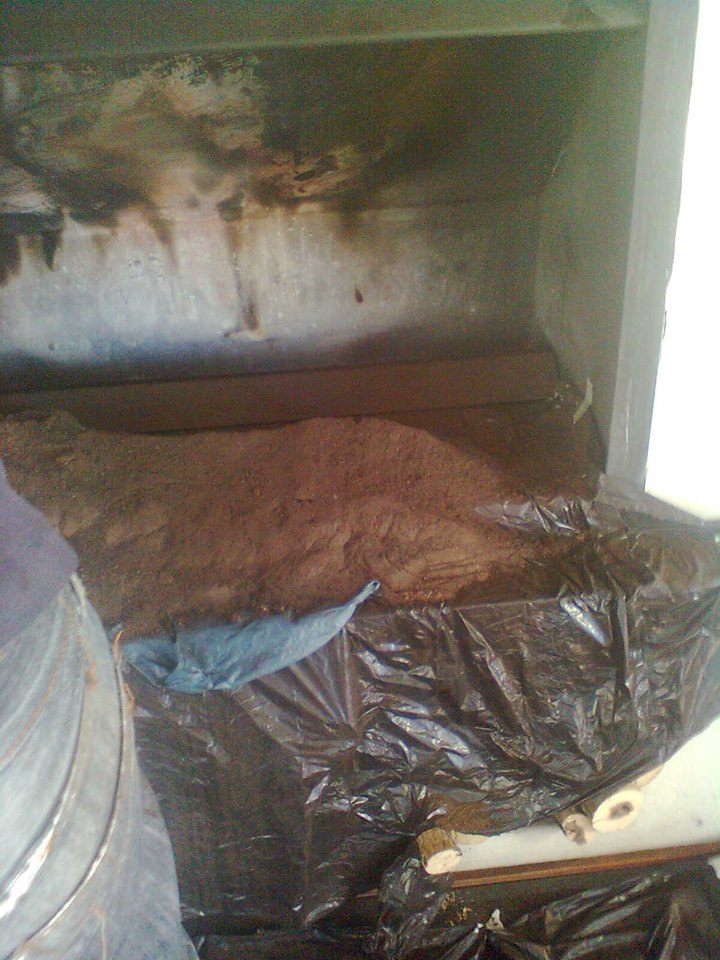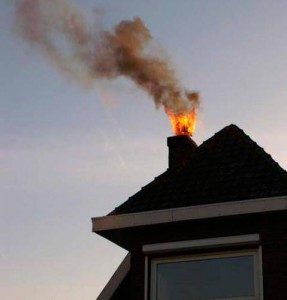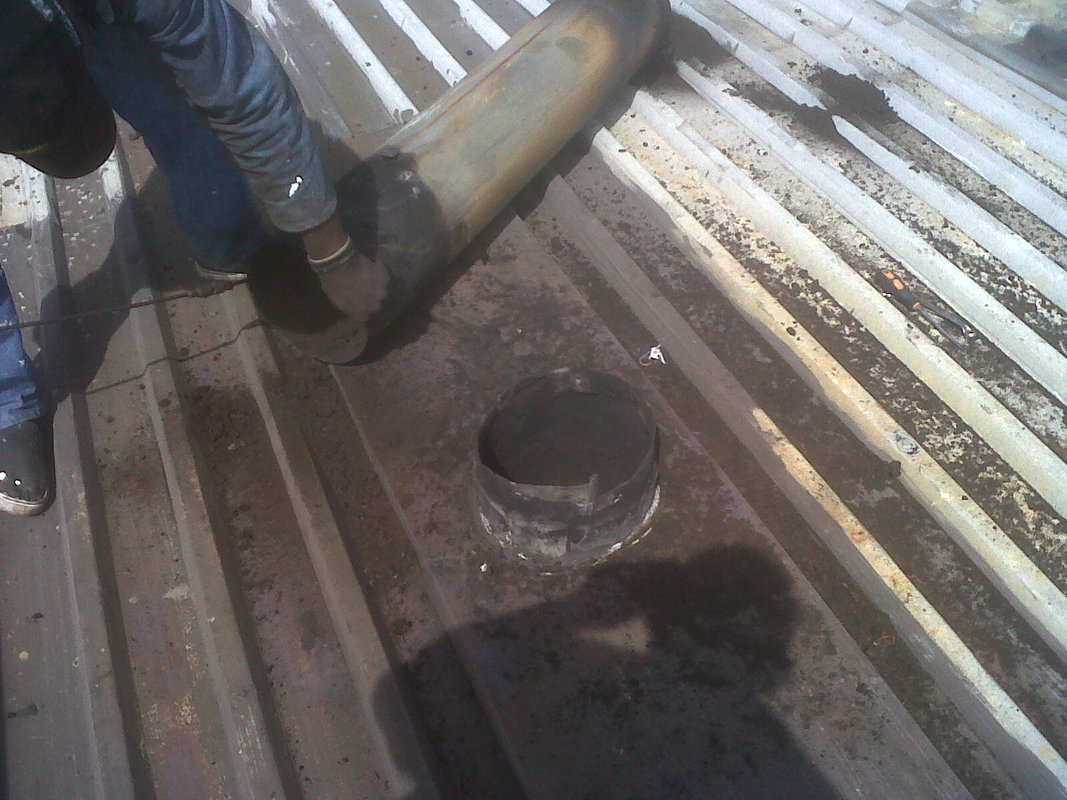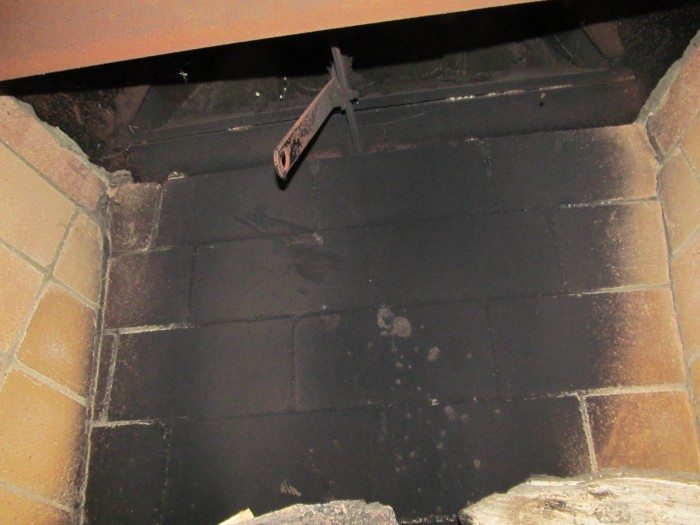 This photo demonstrates how, one spark can set off a chimney fire, within a chimney that has not been cleaned.
This photo demonstrates how, one spark can set off a chimney fire, within a chimney that has not been cleaned.
Frequently asked questions
Why do I need to clean my chimney?
A: Creosote is a highly flammable substance that builds up in your chimney and fireplace as a result of burning wood. Creosote can ignite with just one ember spark which can cause a chimney and/or house fire.
What does the chimney sweep do?
A: The chimney sweep will first tarp off the area
surrounding your stove or fireplace. He cleans from the inside up with his brushes.After the sweep is finished cleaning he will inform you of any issues and/or make
recommendations for repairs.
How long does a chimney sweep take?
A: Residential fireplaces take about 20 minutes to an hour, depending when last your chimney was cleaned and how much it has been used. Whereas commercial chimneys will take longer based on length and frequent usage. Remember the more fires you burn within the fireplace the more frequently it will need to be swept. Do not wait as soot buildup is highly flammable.
Does the chimney sweep need to come inside the
house?
A: Yes. We also need access to a working electrical outlet.
Is it messy or noisy?
The Original Chimney Sweep prides itself in a no mess policy.
Why do I need to clean my chimney?
A: Creosote is a highly flammable substance that builds up in your chimney and fireplace as a result of burning wood. Creosote can ignite with just one ember spark which can cause a chimney and/or house fire.
What does the chimney sweep do?
A: The chimney sweep will first tarp off the area
surrounding your stove or fireplace. He cleans from the inside up with his brushes.After the sweep is finished cleaning he will inform you of any issues and/or make
recommendations for repairs.
How long does a chimney sweep take?
A: Residential fireplaces take about 20 minutes to an hour, depending when last your chimney was cleaned and how much it has been used. Whereas commercial chimneys will take longer based on length and frequent usage. Remember the more fires you burn within the fireplace the more frequently it will need to be swept. Do not wait as soot buildup is highly flammable.
Does the chimney sweep need to come inside the
house?
A: Yes. We also need access to a working electrical outlet.
Is it messy or noisy?
The Original Chimney Sweep prides itself in a no mess policy.
 The photo to the above shows how bad the inside of your flue gets. Depending on the type of wood and the moisture content of your wood your flue may need cleaning twice a year. Generally however at the end of the fire season is sufficient. We highly recommend that you clean your flue at the end of each season rather than waiting until the start of the next one. This way there is no corrosive material left in the flue system throughout the entire summer.
The photo to the above shows how bad the inside of your flue gets. Depending on the type of wood and the moisture content of your wood your flue may need cleaning twice a year. Generally however at the end of the fire season is sufficient. We highly recommend that you clean your flue at the end of each season rather than waiting until the start of the next one. This way there is no corrosive material left in the flue system throughout the entire summer.
What is creosote (soot)?
The word "soot" sounds so simple and harmless. To some, it conjures up images of campfires and candles, and perhaps a charming dance scene from Mary Poppins.
In fact, soot is anything but simple and is certainly not harmless.
Soot includes the fine black particles, chiefly composed of carbon, produced by incomplete combustion of coal, oil, wood, or other fuels. Soot can consist of acids, chemicals, metals, soils, and dust. The common trait of soot particles is that they are extremely tiny – 2.5 micrometers or smaller in diameter. This is smaller than dust and mold, and is about 1/30 the diameter of a human hair.
This combination – extremely small size and toxic composition – is what makes soot so dangerous. It can travel deep into the lung, where the compounds it consists of can do some serious damage.
Scary fact is that 90% of our customers do not know that soot is dangerous. Give The Original Chimney Sweep a call to avoid this problem.
Have a look at our guy on this You Tube link cleaning out loads of soot youtu.be/HHlyJnEH_HU
What is creosote (soot)?
The word "soot" sounds so simple and harmless. To some, it conjures up images of campfires and candles, and perhaps a charming dance scene from Mary Poppins.
In fact, soot is anything but simple and is certainly not harmless.
Soot includes the fine black particles, chiefly composed of carbon, produced by incomplete combustion of coal, oil, wood, or other fuels. Soot can consist of acids, chemicals, metals, soils, and dust. The common trait of soot particles is that they are extremely tiny – 2.5 micrometers or smaller in diameter. This is smaller than dust and mold, and is about 1/30 the diameter of a human hair.
This combination – extremely small size and toxic composition – is what makes soot so dangerous. It can travel deep into the lung, where the compounds it consists of can do some serious damage.
Scary fact is that 90% of our customers do not know that soot is dangerous. Give The Original Chimney Sweep a call to avoid this problem.
Have a look at our guy on this You Tube link cleaning out loads of soot youtu.be/HHlyJnEH_HU
Why Do I Need My Chimney Cleaned?
The chimney flue is essentially a household exhaust pipe - funneling away soot, hot ashes, smoke and gases from your home. An annual inspection and clean should be done at least once a year to check for cracks, holes or faults and to remove soot, creosote, birds nests and other blockages.
My Fire Is Not Drawing Properly?
This is usually the result of a cold or obstructed flue or insufficient height relative to the ridge of the roof or an adjacent building. Large unnecessary voids at the base of your chimney may also stop the fire drawing properly.
My Fire Creates Excessive Soot?
This can be the result of a lazy and inefficient flue. Your flue may not be the right diameter for the fire or stove, or it may not be properly insulated, meaning fumes do not rise fast enough and soot deposits are created. Excessive soot and tar can be a real fire hazard, particularly if the chimney structure has deteriorated.
I’ve Got Mortar Falling Into My Fireplace?
Bits of brick or mortar falling down the flue indicate a serious deterioration in the chimney structure. This deterioration normally occurs from the inside of the flue but it might also indicate weakness on the outside of the chimney.
My Chimney Breast Feels Hot?
This means that the chimney has deteriorated and may be dangerous. If stains also appear on the chimney breast this is a sign that tar or acids have condensed and are eating into the chimney mortar and brickwork.
I Want My Chimney Removed. Should I Do It Myself?
Removing chimneys is dangerous work, so the simple answer is no. A small chimney can weigh around half a tonne, whilst bigger ones can weigh up to eight tonnes. Chimneys built before 1900 are made with lime mortar much of which has now degraded to dust. Weight is the only thing holding them together. Brick structures are expected to last for 50 years so any buildings older than the 1960's should be inspected by a professional to make sure they're safe. This is also how you get a bird out of a chimney cape town
Cancellation Policy:
At the Original Chimney Sweep we are committed to providing our customers with exceptional service. When customers cancel appointments without notice they prevent other sweeps from being carried out during that time.
We will now require a written notification emailed to ian@chimneysweeps.co.za 48 Hours prior to your appointment or we will charge a 50% cancellation fee.
Please do not leave voicemails as we do not have one activated only a email will be accepted for cancellation.
At the Original Chimney Sweep we are committed to providing our customers with exceptional service. When customers cancel appointments without notice they prevent other sweeps from being carried out during that time.
We will now require a written notification emailed to ian@chimneysweeps.co.za 48 Hours prior to your appointment or we will charge a 50% cancellation fee.
Please do not leave voicemails as we do not have one activated only a email will be accepted for cancellation.
Problem Chimneys
|
|
|
|






